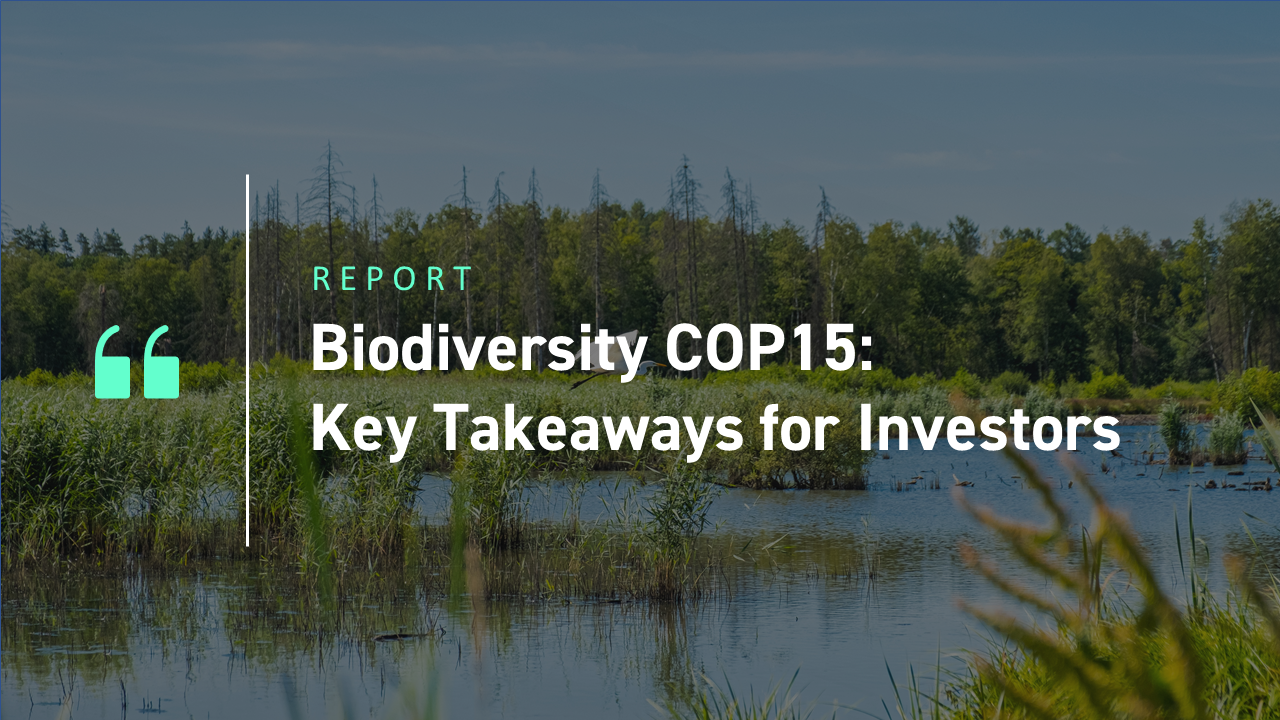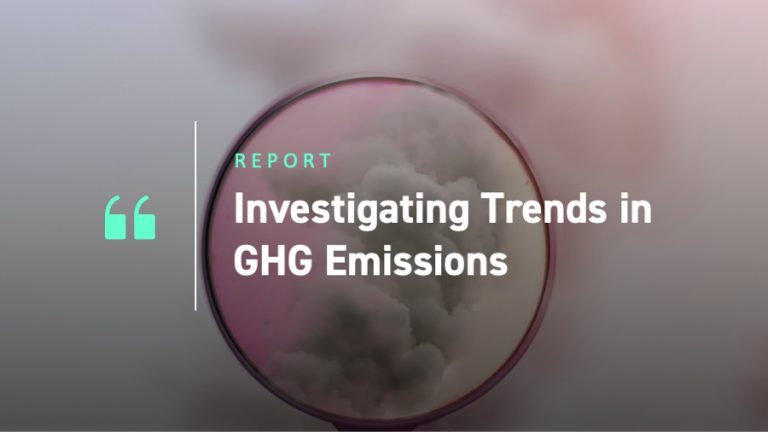Biodiversity is an increasingly important topic for investors and corporations alike. The 15th meeting of the Conference of the Parties (COP15) to the Convention on Biological Diversity (CBD) took place in 2022 in Montreal, Canada. Conference participants discussed topics including equitable access to resources, unsustainable agricultural practices, the rights of indigenous people, and the role of financial flows in protecting biodiversity. The outcomes of COP15 will inform country-level actions for the coming years and have significant implications for how business is done around the world.
The proceedings at 2022’s Biodiversity COP15 were closely watched by ISS, and the following reports have been prepared by the ISS ESG & ISS Corporate Solutions business units:
- Biodiversity COP15: Key Takeaways for Investors; and
- Biodiversity COP15: Key Takeaways for Companies
KEY TAKEAWAYS
- The landmark deal reached at COP15 provides a solid framework, with measurable goals and targets, and an overall commitment to increase global biodiversity and nature-related finance.
- As a result of the launch of new initiatives such as Nature Action 100, investors are expected to further address biodiversity-related risk in their assessment and engagement strategies.
The Kunming-Montreal Global Biodiversity Framework
Following weeks of high-level negotiations, the delegates from 188 governments agreed on December 19th, 2022, to a landmark deal to guide global action to protect nature and restore ecosystems. Hosted by Canada and chaired by China, the UN Biodiversity Conference (CBD-COP 15) was a critical moment for tackling global biodiversity loss by setting a new Global Biodiversity Framework.
The Kunming-Montreal Global Biodiversity Framework (GBF) contains ambitious goals and targets, which, if achieved, will result in halting or slowing nature loss by the year 2030. The framework includes four long-term comprehensive global goals (2050 Vision for Biodiversity), as well as 23 action-orientated targets (to be achieved by 2030). See Table 1 for a summary of GBF’s four long-term goals.
Table 1: The Four Kunming-Montreal Global Biodiversity Framework Goals
| GOAL | Description |
| 1 | Reducing the rate of species extinction by tenfold by 2050 |
| 2 | Supporting the achievement of sustainable development by improvements in the management and use of biodiversity, including ecosystem services |
| 3 | Equitable sharing of the monetary and non-monetary benefits of the applications of genetic resources |
| 4 | Providing adequate resources (financial, technical, capacity-building, etc.) to allow for full implementation of the Kunming-Montreal Global Biodiversity Framework |
As mentioned, the final version of the GBF also encompasses 23 targets. These targets include restoring 30% of the global marine and terrestrial ecosystems, as well as effective management of 30% of the oceans, lands, and coastal areas by the year 2030 (known as 30×30). See Table 2 for a summary of GBF’s 23 final targets.
Table 2: Overview of the 23 Kunming-Montreal Global Biodiversity Framework targets
| Target | Description |
| 1 | Manage land and sea use change effectively, to reduce the loss of areas with high biodiversity importance to close to zero by 2030 |
| 2 | Ensure the effective restoration of 30% of degraded terrestrial, inland water, and coastal and marine ecosystems by 2030 |
| 3 | Ensure effective conservation and management of 30% of terrestrial, inland water, and coastal and marine areas by 2030 |
| 4 | Halt human-induced extinctions and maintain and restore genetic diversity within and among populations of native, wild, and domesticated species |
| 5 | Ensure sustainable use, harvesting, and trade of wild species in a safe, sustainable, and legal manner |
| 6 | Mitigate or eliminate the impacts of invasive alien species and reduce the rates of establishment of invasive species by 50% by 2030 |
| 7 | Reduce pollution risks and impacts from all sources by 2030, reducing the overall risk from pesticides by half as well as reducing or eliminating plastic pollution |
| 8 | Minimize the impacts of climate change and ocean acidification on biodiversity via mitigation, adaptation, and disaster risk reduction |
| 9 | Ensure sustainable use and management of wild species, while protecting customary use by local communities and Indigenous peoples |
| 10 | Manage areas under agriculture, aquaculture, fisheries, and forestry sustainably |
| 11 | Restore and enhance ecosystem function through nature-based solutions and ecosystem-based approaches |
| 12 | Increase the area and quality of urban green and blue spaces to ensure biodiversity-inclusive urban planning |
| 13 | Share the benefits arising from the use of genetic resources fairly and equitably |
| 14 | Integrate biodiversity into policies and development across all sectors, including aligning public and private activities |
| 15 | Provide policy measure to enable businesses to monitor, assess, and disclose their impacts on biodiversity |
| 16 | Encourage sustainable consumption, including by reducing food waste by half by 2030 |
| 17 | Strengthen capacity for biosafety measures and ensure benefits sharing from biotechnology |
| 18 | Identify and eliminate harmful subsidies in a just way, reducing them by $500 billion by 2030 |
| 19 | Increase financial resources substantially, mobilizing $200 billion per year by 2030 from all sources, including at least $20 billion per year by 2025 and at least $30 billion per year by 2030 |
| 20 | Strengthen capacity-building development and technology transfer |
| 21 | Promote integrated and participatory management, including the use of traditional knowledge, innovations, practices, and technologies |
| 22 | Ensure full, equitable, inclusive representation and participation of local communities |
| 23 | Ensure gender equality in the implementation of the framework |
Source: Carbon Brief, CBD
Currently none of the components of the GBF are legally binding. However, countries will be required to assess and demonstrate their progress, in line with the framework’s goals and targets, via national reports.
COP15: A Call to Action for Investors
The successful implementation of the GBF will likely require a complete transformation of people’s relationships with nature and biodiversity, including the production, consumption, and trading of goods and services. As a result, COP15 attracted the attention of many business leaders and fund managers.
In addition to the 30×30 (protect 30% of the oceans, lands, and coastal areas and restore 30% of ecosystems by 2030) target, the agreement also includes a number of objectives to encourage and increase investments in biodiversity and nature protection via impact funds or other instruments led by the private sector. One example is Target 14, which ensures
The full integration of biodiversity and its multiple values into policies, regulations, planning and development processes, poverty eradication strategies, strategic environmental assessments, environmental impact assessments and, as appropriate, national accounting, within and across all levels of government and across all sectors, in particular those with significant impacts on biodiversity, progressively aligning all relevant public and private activities, fiscal and financial flows with the goals and targets of this framework.
The implementation of Target 14, in the long-term, could further encourage and provide additional incentives for the financial sector to take advantage of nature-related investment opportunities. This is backed by Target 18, which calls for eliminating or reducing (by at least $500 billion per year by 2030) incentives and subsidies harmful for biodiversity.
To help finance the framework, the agreement also includes additional commitments (Target 19) from all parties to “Substantially and progressively increase the level of financial resources from all sources… to implement national biodiversity strategies and action plans, by 2030 mobilizing at least 200 billion United States dollars per year.” In addition to increasing financial flow to the developing countries ($20 billion by 2025 and $30 billion by 2030), Target 19 also calls for leveraging private finance, including impact funds and other similar instruments. Use of innovative schemes such as “payment for ecosystem services, green bonds, biodiversity offsets and credits, benefit-sharing mechanisms” are also encouraged.
Many investors were particularly interested in the final wording of Target 15, which requires governments to take legal or policy measures to enable and encourage business and financial institutions to: “Regularly monitor, assess, and transparently disclose their risks, dependencies and impacts on biodiversity including with requirements for all large as well as transnational companies and financial institutions along their operations, supply and value chains and portfolios.”
The failure to make such reporting mandatory has led to criticism from some delegates. However, many are still hopeful that the adaptation of Target 15 in its current format could still stipulate an increase in biodiversity and nature-related reporting in coming years.
Led by Colombia and supported by Germany, COP15 also saw the launch of the National Biodiversity Strategies and Action Plans (NBSAPs). The partnership, which includes 23 countries and international organizations, aims to facilitate the achievement of Kunming-Montreal Global Biodiversity Framework goals and targets through improved access to technical and financial support, knowledge-sharing, and improved overall stakeholder dialogue and engagement.
A key development during the COP15 was the launch of the Nature Action 100. An investor-led engagement initiative, Nature Action 100 aims to reduce nature and biodiversity loss by pushing for greater corporate ambition and action. Similar to Climate Action 100+, Nature Action 100 will engage with companies active in key sectors that have been determined to be of importance in reversing nature and biodiversity loss by 2030. AXA Investment Managers, BNP Paribas Asset Management, and Robeco are among the initial group of institutional investors behind this initiative. Large investors and asset owners engaging with companies to develop transparent long-term concrete goals and targets is a significant instrument in ensuring companies’ reduction of negative impact on nature and biodiversity.
Challenges and Opportunities for Investors
Biodiversity loss and the degradation of ecosystem services could lead to significant risks (transitional, physical, regulatory, reputational) for businesses and investors. In recent years, biodiversity has become one of the most important ESG themes and is likely to gain more traction among investors seeking to reduce negative impacts and in some cases drive up positive biodiversity outcomes.
Considering that almost all the previous Aichi Biodiversity Targets (adopted during the 2010 U.N. Convention on Biological Diversity summit in Nagoya) were not fully met by 2020, achieving the goals and targets of the COP15 agreement might seem rather ambitious. Regardless, COP15 and the Kunming-Montreal Global Biodiversity Framework (GBF) provide investors with a clear long-term policy framework to integrate nature-related investment at a larger scale. Currently investors can address biodiversity loss in two ways:
- Assessing the impact of biodiversity loss in their portfolios
- Increasing investment in nature-based solutions
To better integrate biodiversity considerations into the investment decision-making process, whether by re-allocating capital or prioritizing high-impact corporate engagement with companies that lag on biodiversity, investors will require reliable and consistent biodiversity-related data. In recent years, various new initiatives have aimed to reduce existing complexity related to biodiversity measurement and metrics and to remedy a lack of general guidelines. The Taskforce on Nature-related Financial Disclosures (TNFD) recently released the v0.3 of its beta framework, which includes new disclosure recommendations on supply chains and guidelines on incorporating nature-related dependencies, as well as guidance on risk and opportunity assessment.
To support investors seeking to align with rapidly evolving voluntary and statutory biodiversity disclosure frameworks and to help investors measure the impact of their investment portfolios on biodiversity, ISS ESG has recently launched its Biodiversity Impact Assessment Tool. The tool leverages a bottom-up assessment of a company’s business activities and supply chain to demonstrate the impact of operations on biodiversity. The full solution includes approximately 600+ individual factors (including impact per region and activity) derived from millions of individual datapoints, allowing for granular analysis and understanding.
Explore ISS ESG solutions mentioned in this report:
- ISS ESG’s Biodiversity Impact Assessment Tool helps investors assess the impact of companies’ business and supply chain activities on biodiversity.
By: Reza Marvasti, ESG Product Manager, Biodiversity & Alternative Asset Solutions, ISS ESG




